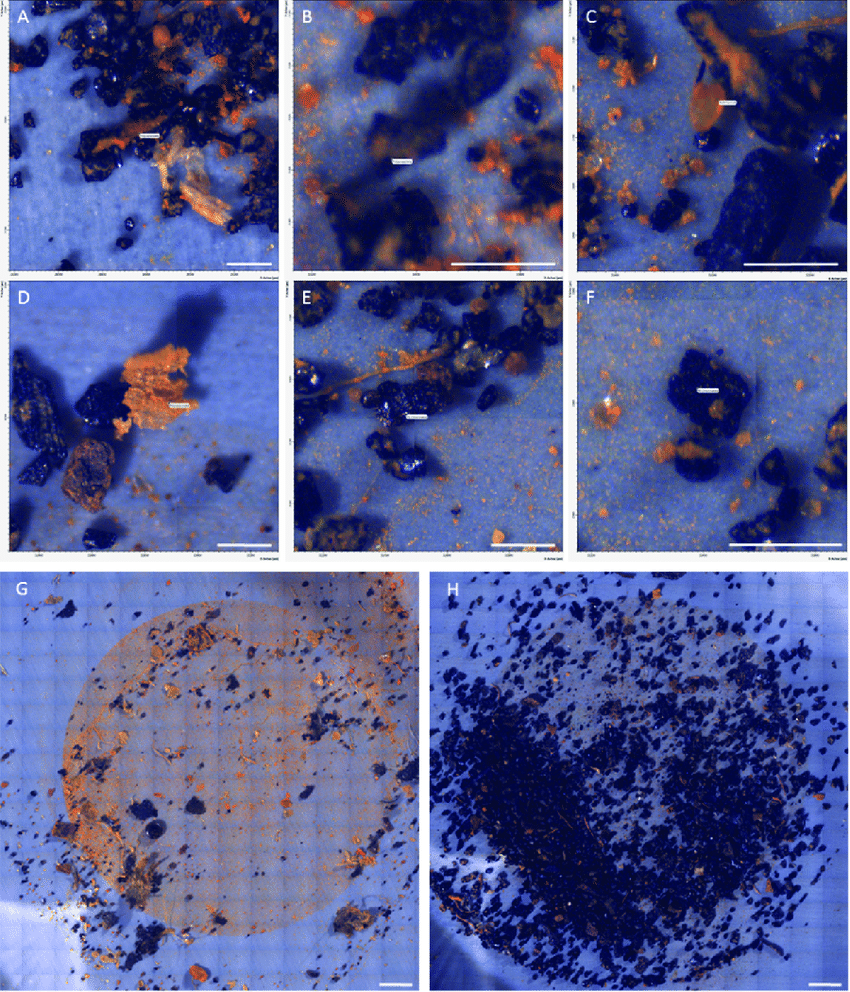The Highest Level of Micro-plastics Ever Recorded!
A team of international scientists have found the highest level of microplastics ever recorded on the seafloor, with up to 1.9 million pieces recorded in a thin layer of sediment, covering just one square meter.
Panel showing examples of microplastic particles and an overview over exemplary samples. (A) Polycarbonate; (B) polypropylene; (C) polyurethane/varnish; (D) polycarbonate; (E,F) chlorinated polyethylene; scale bar A-F: 200 μm; (G) overview of sample HG-IX; (H) overview of sample HG-VII with many coal particles; scale bar G,H: 1 mm. Source: Bergmann et al., (2017)
Every year more than 10 million tonnes of plastic debris enters the world's oceans. With well known documentaries like "Blue Planet Effect" much public awareness has been generated about the plastic problem humanity has and how it is impacting our marine ecosystems. This has led to a global movement to boycott the use of plastic straws and shopping bags, however, with the sheer damage that has already been done, humanity and our oceans face a consequential threat...microplastics!
Up to 99% of ocean plastics are found in the deep ocean, but until recently it has been unclear where this plastic winds up. New research published this week in the journal Science
has revealed that deep sea ocean currents act as conveyor belts that transports tiny plastic fragments and fibres across the seafloor. These are known as microplastics, which by definition are plastic debris less than 5 millimeters across. The research was conducted by a team of international scientists from the University of Manchester (U.K.), the National Oceanography Centre (U.K), University of Bremen (Germany), IFREMER (France) and Durham University (U.K).
The new study showed how ocean currents can in-fact concentrate microplastics within a huge sediment accumulation, which they termed "microplastic hotspots". These hot-spots are located in the deep sea and have been made akin to accumulation of floating plastic i.e. the "garbage patches" formed by surface currents. These microplastics were mainly composed of fibres from clothing and textiles that are not effectively filtered out in domestic waste water treatment plants, and enter the rivers and our oceans. In the ocean, they can settle slowly or be transported rapidly by episodic turbidity currents that travel down submarine canyons to the deep seafloor. Once in the deep sea, the microplastics are taken by continuously flowing seafloor currents that concentrate the fibres and fragments in large drifts of sediment.
The study site was located on the seafloor of the Tyrrhenian Sea (part of the Mediterranean Sea), where samples collected were combined with calibrated models of deep ocean currents and detailed mapping of the seafloor. Back in the laboratory, scientists separated the microplastics from sediment and counted the fragments under a high powered microscope. In addition, they further analysed the samples using infra-red spectroscopy to determine the types of plastics. This allowed the research team to determine the distribution of microplastics on the seafloor.
High levels of microplastics in Arctic deep sea sediments have also been reported from the HAUSGARTEN Observatory, creating mounting evidence of the ubiquity of microplastic in aquatic ecosystems worldwide, and enhancing our knowledge of its distribution in remote environments such as Polar Regions and the deep sea at 2,340 - 5,570 m depth.
Abundance and composition of microplastics detected in sediments from the Artic deep sea. Source: Bergmann et al., (2017)
Other research on microplastics have shown that the problem is pervasive from the oceans surface to the seafloor and are now entering ocean food-webs through filter feeding marine organisms such as pelagic red crabs and larvaceans. Pelagic red crabs are commonly found near the oceans surface and are consumed by many species of fishes, including tunas.
© Ocean Research & Conservation Ireland (O.R.C.Ireland) and www.orcireland.ie , est. 2017. If you like our blogs on the latest news in marine science and would like to support our work, visit www.orcireland.ie to become a member, to volunteer or to make a donation today. This article has been composed based on credible sources.
References:
Bergmann, M.,Wirzberger, V., Krumpen, T.,Lorenz, C., Primpke, S., Tekman, M. B., Gerdts, G., (2017). High quantities of microplastic in Arctic deep-sea sediments from the HAUSGARTEN observatory. Environmental Science & Technology
, 51
DO - 10.1021/acs.est.7b03331
Choy, A.C., Robison, B.H., Gagne, T.O., Erwin, B., Firi, E., Halden, R.U., Hamilton, A.J., Katija, K., Lisin, S.A., Rolsky, C., Van Houtan, K.S., (2019). The vertical distribution and biological transport of marine microplastics across the epipelagic and mesopelagic water column. Scientific Reports
, 9
, (1).
Kane, I.A., Clare, M.A., Miramontes, E., Wogelius, R., Rothwell, J.J., Garreau, P., Pohl, F., (2020). Seafloor microplastics Hotspots Controlled by Deep Sea Circulation. Science.
SHARE THIS ARTICLE















